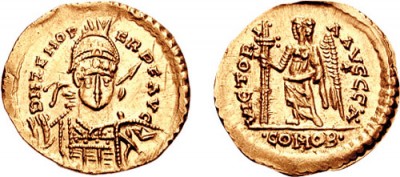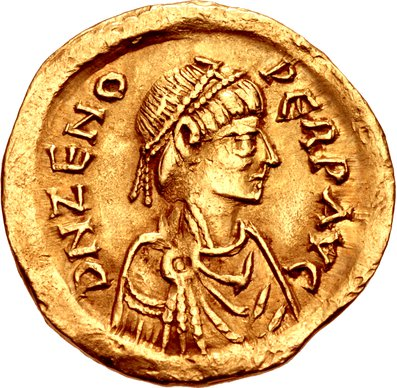Zeno (Zeno)
Zeno was summoned to Constantinople in 466 by Emperor Leon I. Zenon was the chief of the Isaurian tribe, whom Leo called to Constantinople as his personal guard. In this, Leo wanted to break free from the influence of the Germanic army commander Aspar. We know almost nothing about his life up to this point. His original name was Tarakoddisa (Tarasakodissa). He was born in the village of Rusumblada, which was probably named after his father. His mother was Lallis,. He married the daughter of Emperor Leo I, Ariadne. He had two sons with her, Leon II. and Zenon, but the latter died during his father's reign.
After the assassination of Aspar in 471, the Isaurians took power over the empire into their own hands. When Leon I died in 474, his grandson and son of Zeno, Leon II, ascended the imperial throne. He proclaimed his father Zeno co-emperor on February 9, 474. And when he died shortly thereafter, Zenon became sole emperor. This happened on 17. November 474.
Shortly after his accession to the imperial throne, in January 475, a popular uprising against Zeno broke out in Constantinople. Zeno was forced to leave Constantinople and the Empress Verina's brother, Basiliskos, was elected emperor. But he ruled very unhappily and antagonized almost everyone. Therefore, a year later, with the support of the army, Zenon again sat on the imperial throne. At the very time that Zeno became emperor for the second time, the last emperor, Romulus Augustus, had been deposed in the west. The Odoaker, whom the Germanic people of Italy had chosen as their king, asked Zeno to confer on him the title of parthia. He further asked him to allow him to administer Italy in Zeno's name. This, however, Zenon refused.
After regaining the throne, Zenon had to deal with Basilisk's biggest supporter. This was the Ostrogothic chieftain Theodorich Strabo. He used against him what the Byzantines knew best, namely diplomacy. Zen succeeded in pitting another Ostrogothic chieftain based in Pannonia, Theodorich of the tribe of Amal, against Strabon. The period between 475 and 481 was filled with constant fighting between the Ostrogoths and the Byzantines. Only when Strabo died in 481 did Zeno reach a settlement with the Goths and confer the title patrikios
on Theodorich of Amal.
In 484 Leontios, with the support of the Isaurian chieftain Ilos, proclaimed himself emperor and settled in Antioch, controlling the eastern part of the empire. It was not until 488 that Zeno succeeded in defeating Leontius and becoming sole ruler over the empire. In the same year, Zeno also succeeded in ridding himself of the Gothic threat. He persuaded Theodoric to withdraw to Italy. In Zeno's name, he was to defeat Odoacre and take control of Italy. When the Goths withdrew, Zenon was able to set about solving internal problems.
In 482, Zeno issued an imperial edict called the Henotikon. This edict was a sort of compromise between the church representatives of orthodoxy and monophysitism. There seemed to be a reconciliation of the two sides. Especially after Patriarch Akakios of Constantinople agreed to the edict. However, the Roman Pope Felix III, who disagreed with the edict, intervened in the dispute. He excommunicated Akakios from the Church. But in return, so did Akakios (Akakios Schism). Thus, for the first time, a serious rift arose between Rome and Constantinople. After these events, the Edict of Zeno was also rejected by the representatives of Monophysitism.
Zeno died on 9 April 491.
Author's Collective: History of Byzantium, published by Academia, Nakladatelství Československé akadémie věd - Prague 1992, ISBN 80-200-0454-8
www.roman-emperors.org
Tento solidus nechal razit Odoaker jménem Zenona. Odoaker vládl Itálii pod formálním patronátem východního císaře.
Classical Numismatic Group, CC BY-SA 3.0, commons.wikimedia.org
Semissis císaře Zenona. Konstantinopolská mincovna. Ražba 477-491 n. l.
Classical Numismatic Group, CC BY-SA 2.5, commons.wikimedia.org
Evropa a Středomoří při pádu Západořímské říše v roce 476
Guriezous - Putzger Historischer Weltatlas, Cornelsen, Berlin 1992 ISBN 3-464-00176-8, pp. 34-35, CC BY-SA 4.0, commons.wikimedia.org


